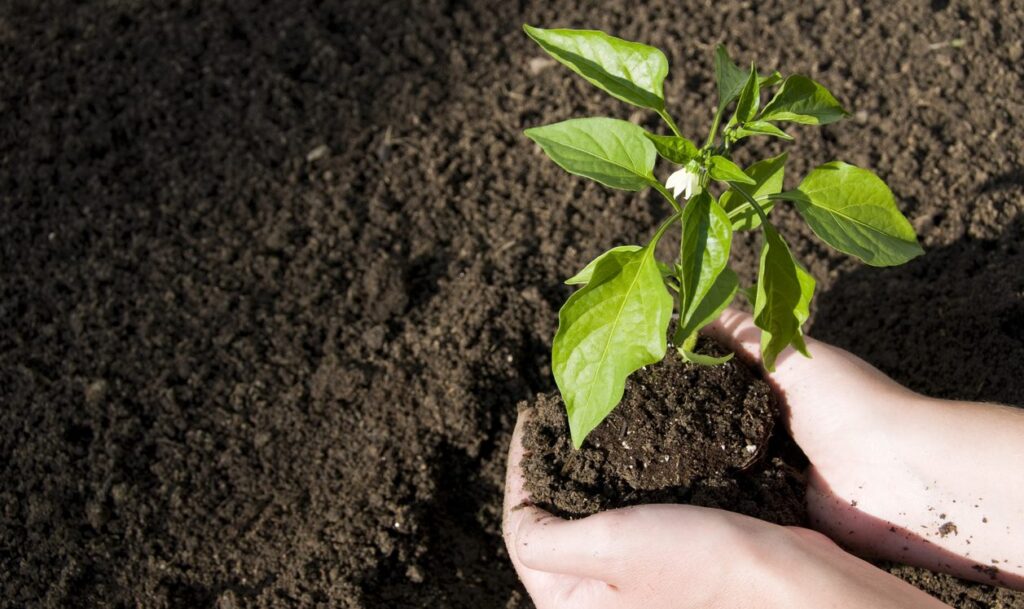By, the old guy with a pony tail at Mendham Garden Center
You can call it dirt, soil, root zone or a host of other terms. It’s the downside to the establishment and management of your lawn. Topsoil
A turf manager once told me, “You can grow grass on a rock, just give it what it needs”. Although this is true, deep healthy topsoil works a whole lot better.
Soil is a mixture of sand, silt and clay. Sand particles are largest. Silt is smaller and clay particles are the smallest. Topsoil is different from sub soil in that it also contains organic matter built up over years of decaying animals and plants.
Eight inches or more topsoil is optimal for growing grass. At the very least, you’ll need three to four inches. Under normal conditions, the deeper a healthy topsoil layer goes, the more resilient the grass.
Organic matter in the topsoil causes the sand, silt and clay particles to bond together forming soil aggregates. These large particles have small and large spaces between them called pore space.
Essentially, the soil acts like a big sponge. Larger spaces allow water, nutrients and oxygen to enter the root zone and gases to escape. Smaller spaces hold moisture and nutrients, making them available to the grass and helping the grass grow and develop.
Soils, such as our native clay soils with less than 85% sand depend on soil aggregation (the formation of soil aggregates) to drain and maintain an adequate level of both large and small pore space to support turf development.
Adding sand to soil can help improve drainage. However, you’ll need to add sand in the proper amount or size. The wrong mix can end up hindering rather than improving drainage. Organic matter or compost is sometimes the better choice because over time it can help create the aggregation necessary to sustain drainage in a heavy textured clay soil.
Air space and microorganisms
Topsoil is full of microorganisms. How full? If you dug a teaspoon into the earth, you’d find as many microscopic lifeforms inside that scoop of dirt as there people on the planet.
Most of those microorganisms require oxygen to break down organic matter and supply nutrients to the grass in the process of decomposition, much like what happens in a compost bin.
Although some microorganisms do not require oxygen and can function in an anaerobic environment, most beneficial microbes are aerobic and require oxygen to function.
Grass seeds
A grass seed contains everything it needs to germinate and sprout, except moisture. Like all grains, grass seeds contain starch. The seed also contains the same enzyme that is in saliva. This enzyme converts the starch to sugars (carbohydrates). Once germinated, the seed uses these carbohydrates for energy to develop until it can produce the carbohydrates it needs through photosynthesis in its newly developing green leaves.
Meanwhile, the grass plant is also developing its root system which penetrates into the soil. This root system continues to mine out the moisture and nutrients the grass needs to survive.
Roots are continually dying as new roots develop. Although the root system is typically shallower in the summer and deeper in the spring and fall, the depth of the root system is somewhat relative to the managed height of the grass.
Grass mowed at a lower height will usually have a shallower root system than a grass maintained at a higher height. Raising the mower height in the summer supports a deeper root system to more effectively search out water and nutrients.
Soil compaction
Soil compaction occurs naturally, even without the effects of traffic. Every time it rains, the moisture lubricates the soil particles and they move closer and closer together, creating more compaction.
The more silt and clay (small particles) and less aggregation a soil contains, the more potential there is for compaction to negatively impact the ability of the soil to support a deep healthy root system.
In a typical winter, freezing and thawing tend to open up the soil and relieve compaction, which is why soil is usually most compacted at the end of the summer. Early fall, when the grass is actively growing, is the time soil aeration by mechanical means is most beneficial. Soil aeration helps the grass to regenerate a deeper root system after the long hot summer
Compacted soil compromises literally every function of a healthy, continually developing lawn. A lack of oxygen hinders aerobic microbes’ ability to break down organic matter and supply nutrients. Roots need large enough pore spaces to penetrate the soil and develop.
As the roots continue to grow and elongate, they continually mine nutrients and moisture from the soil. Once root growth is restricted the plant can deplete readily available nutrients.
Dry compacted soil can minimize nutrient availability to the roots by as much as 50%. Once the health of a lawn is compromised, the lawn becomes more susceptible to damage caused by environmental conditions, insect and disease.
Soil aeration is very beneficial in developing and maintaining a healthy lawn. It is a much underused procedure in residential lawn care. Aeration, when used effectively, can help to minimize compacted soil conditions. When incorporated with topdressing and or effective fertilization program, soil aeration can help to transform a poor soil into a more suitable growth medium.
You could say, when it comes to grass, “what grows up must grow down” and that’s the downside.
If you have any questions or comments on this article you can contact [email protected]
And feel free to pay us a visit at any of our three stores to find everything you’ll need for proper lawn care and healthy topsoil.

